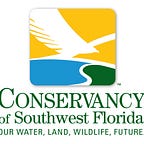Turtle or tortoise? And what’s the difference?
Written by: Conservancy intern Kody Knighten
Many people use the terms turtle and tortoise interchangeably; I know I used to. However, what some people may not realize is that there is a difference between the two! Of course they have similarities such as both have shells and beak like mouths, and they are both reptiles in the order Testudines. However, when you look a little closer at their appearance and behavior, you can see some of the differences.
Turtles spend most (or all) of their life in the water, whether it is saltwater, freshwater or brackish water (a mixture of the two). Because of their preferred habitat, certain species of turtles have adapted to thrive in these environments. Those species that spend the entirety of their lives in the water, such as sea turtles, have adapted flippers instead of feet which enable them to be excellent swimmers. Other turtles, such as sliders or cooters, may still spend a little time on land, so they have feet with webbing in between their toes. This webbing allows for these species to be good swimmers, while at the same time still allowing them to be able to get around on land when they need to or want to. The Conservancy of Southwest Florida currently has three ambassador turtles that you can visit at our Nature Center!
On the other end of the spectrum, tortoises spend their entire lives on land. Some species may never even see a big enough body of water to swim in! Because of where they live, they have no need for webbed feet or flippers. Instead, they have feet that can be described as ‘stumpy’ and ‘elephant-like’ in appearance. Here in Southwest Florida, the only native tortoise we have is the gopher tortoise. These critters are unique and very important in many ways. gopher tortoises prefer upland and dry scrub habitat that is sandy and ideal for lower-growing scrub plants and cacti.
The prickly pear cactus is common in the scrub habitat here in parts of Southwest Florida, and is a favorite food of the gopher tortoise. Since most cacti possess the ability to maintain high volumes of water, it can also serve as the main source of water for tortoises! In a dry, sandy habitat, this can be crucial for their survival!
Many tortoises burrow for shelter, and the gopher tortoise is no exception. They have long flat claws on their front feet that are great for digging burrows. From a conservation stand point, the gopher tortoise burrow is a very important part of our ecosystem! They dig long burrows underground that gradually slant down and eventually level out, averaging between 30–40 feet in length (the record is 47!) Now you might think this burrow is much too long for one tortoise, but while they are responsible for digging the burrow, they are not the only species that utilize it. Over 70 different species of animals have been found to live in gopher tortoise burrows - including burrowing owls, eastern indigo snakes, gopher frogs and eastern diamondback rattlesnakes just to name a few. Because of this, gopher tortoises are considered to be what we call a ‘keystone species’, which means that their survival is essential to the survival of other animals in their ecosystem. If tortoises disappear, many other species will be greatly affected, and maybe even disappear themselves.
Here at the Conservancy of Southwest Florida, we are doing our best to help preserve this unique and important species. We even have our own seven acre gopher tortoise preserve right here on site that is home to a tortoise population, along with many other species! The Smith Preserve is located underneath and on either side of the wooden bridge off of our Goodlette-Frank entrance. So the next time you come for a visit, be sure to take the short walk over to our preserve and see if you can catch sight of these shy but amazing animals!
